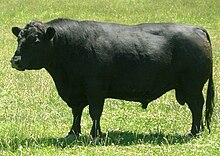Australian Lowline
 Bull | |
| Conservation status | FAO (2007): no data[1]: 4 |
|---|---|
| Other names |
|
| Country of origin | Australia |
| Standard | Australian Lowline Cattle Association |
| Use | beef |
| Traits | |
| Weight | |
| Height | |
| Coat | solid black, occasionally solid red |
| Horn status | polled |
| |
The Australian Lowline is a modern Australian breed of small, polled beef cattle. It was the result of a selective breeding experiment using black Aberdeen Angus cattle at the Agricultural Research Centre of the Department of Agriculture of New South Wales at Trangie.[5]: 3 It is among the smallest breeds of cattle, but is not a dwarf breed.[3]: xxvi
History
In 1929 the Department of Agriculture of New South Wales started an Aberdeen Angus herd at the Agricultural Research Centre at Trangie with stock imported from Canada. Various additions to the herd were made, from Canada, from the United States, from the United Kingdom and from other herds in Australia, until the herd-book was closed in 1964. From about this time, various research projects were conducted at Trangie. In 1974 an investigation of the correlation between growth rate and profitability, and of whether feed conversion efficiency was higher in large or in small animals fed on grass, was begun.[5]: 3
In the study, three separate herds were established: one of animals with a high rate of growth in their first year, one with animals that had shown low growth, and one randomly selected as a control group. These were called the High Line, the Low Line and the Control Line respectively. The Low Line herd started with 85 cows and some young bulls, and was closed to additions of other stock from 1974;[5]: 3 it eventually numbered more than 400.[6] To exclude possible effects of climate from the study, some stock was reared at Glen Innes in northern New South Wales and at Hamilton, Victoria. The experiment ran for nineteen years, by the end of which the Low Line animals were on average some 30% smaller than the High Line group.[5]: 3
When the experiment ended in the early 1990s, the Lowline stock was auctioned off. A breeders' association, the Australian Lowline Cattle Association, was formed in 1992,[5]: 4 and the first herd-book was published in 1993; it listed 150 cows and 36 bulls.[6]
Australia is the only country which reports Lowline cattle to DAD-IS;[7] the breeders' association has members in Canada, New Zealand, the United Kingdom and the United States.[8]: 18
Characteristics
The Australian Lowline is among the smallest of cattle breeds, but is not affected by dwarfism.[3]: xxvi Height is about 60% of that of the normal Aberdeen Angus breed, or about 110 cm for bulls and 100 cm for cows. Calves average about 22 kg at birth, but may weigh as little as 14 kg. The coat is usually solid black, but may also be solid red; some white colouring in the area of the scrotum or udder is tolerated.[4] The cattle are naturally polled and are quiet-tempered.[8]: 18 They adapt well to varying climatic conditions. Cows calve easily and provide plenty of milk to their young.[8]: 18
Compared to larger cattle, the Lowline does less damage to pasture land, and does not need such high or strong fencing.[9]
Use
The Australian Lowline is reared for beef. The meat is well-marbled and tasty; carcass yield is high.[8]: 18
References
- ^ Barbara Rischkowsky, D. Pilling (eds.) (2007). List of breeds documented in the Global Databank for Animal Genetic Resources, annex to The State of the World's Animal Genetic Resources for Food and Agriculture. Rome: Food and Agriculture Organization of the United Nations. ISBN 9789251057629. Accessed January 2017.
- ^ Valerie Porter (2019). Beautiful Cows: Portraits of Champion Breeds. London: Ivy Press. ISBN 9781782407621.
- ^ a b c d Valerie Porter, Lawrence Alderson, Stephen J.G. Hall, D. Phillip Sponenberg (2016). Mason's World Encyclopedia of Livestock Breeds and Breeding (sixth edition). Wallingford: CABI. ISBN 9781780647944.
- ^ a b c Standard for Australian Lowline Cattle. Australian Lowline Cattle Association. Accessed January 2017.
- ^ a b c d e David Barnett (1998). History of Lowlines. In: Foundation Herd Book. Armidale, New South Wales: Australian Lowline Cattle Association.
- ^ a b Lowline cattle. The State of Victoria. Archived 3 April 2016.
- ^ Breed data sheet: Lowline / Australia (Cattle). Domestic Animal Diversity Information System of the Food and Agriculture Organization of the United Nations. Accessed June 2023.
- ^ a b c d Margo Hayes (2016). Small Cattle for Small Farms. Clayton, Victoria: CSIRO Publishing. ISBN 9781486301874.
- ^ Australian Lowline Cattle: A Rare Breed of Australian Origin. Rare Breeds Conservation Society of New Zealand. Accessed January 2017.
